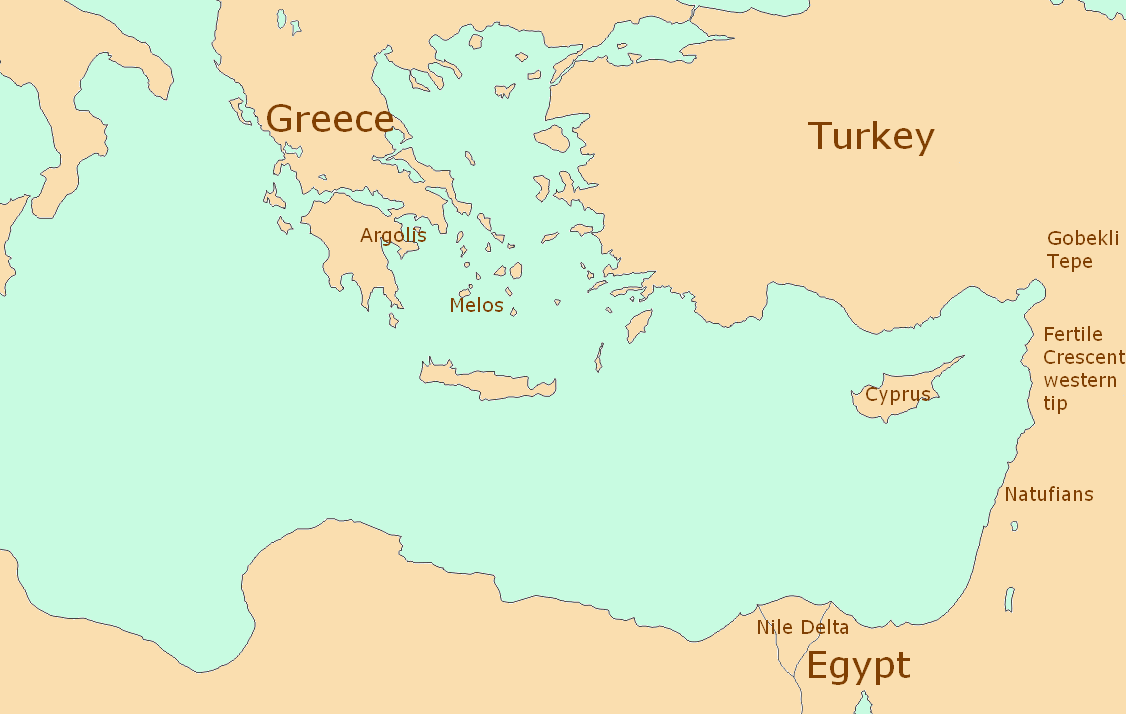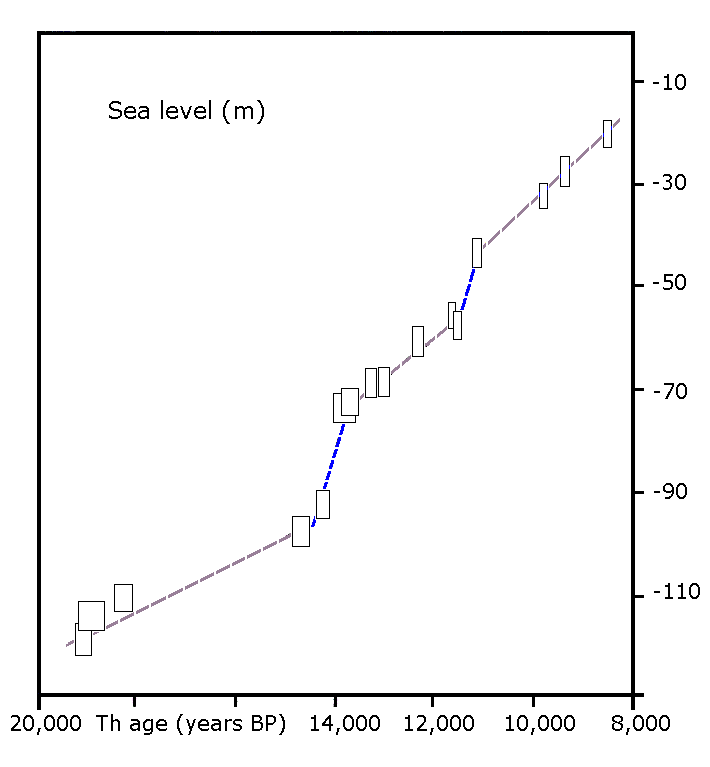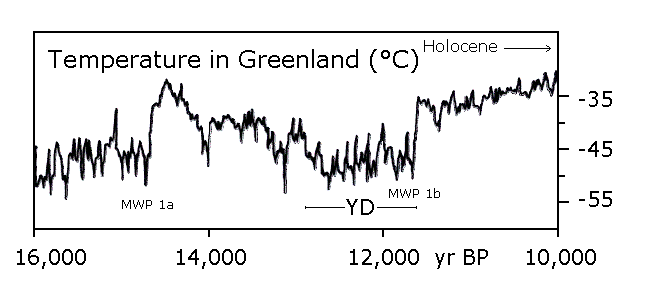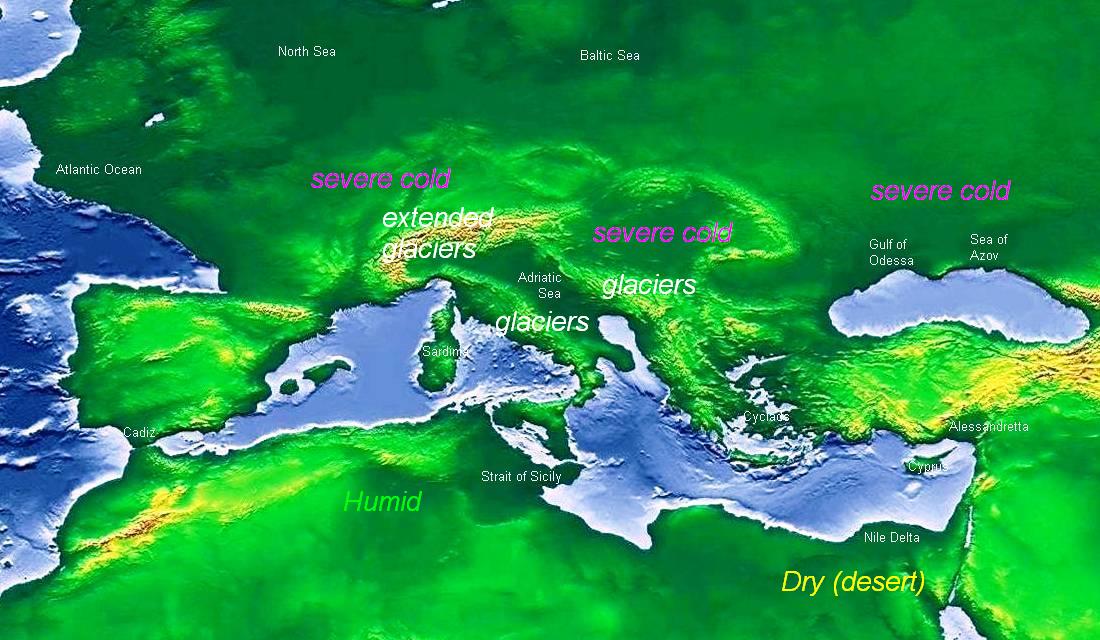The Earth’s climate has not always been the same. For example, in the last half a million years there have been four ice ages interrupted by four much shorter interglacial periods (EPICA 2004). The last ice age began more than one hundred thousand years ago and peaked around twenty thousand years ago, whereupon the temperature began to rise (Clark et al. 2009). During this transitional phase, seafaring spread throughout the Mediterranean and became rather sophisticated. Seventeen thousand years ago this enabled the colonization of Sardinia (Broodbank 2006) and the development of the practice of deep-sea fishing (Cleyet-Merle 1990, p. 26). But thirteen thousand years ago, at the beginning of the Younger Dryas [7] a quantum leap in Mediterranean navigation occurred, with the colonization of Cyprus (Fig. 1), which involved crossing forty nautical miles (Ammerman et al. 2006), and with the establishment of ‘regular’ sea routes for shipping obsidian from the island of Melos to Argolis in mainland Greece (Renfrew and Aspinall 1990).

In the same period, although apparently still hunters/gatherers, humans were able to coordinate themselves to build and decorate with bas-reliefs a large stone temple at Göbekli Tepe in Turkey (Dietrich et al. 2013). A little further south (Fig. 1), in the western tip of the Fertile Crescent, communities began to select grains to grow (Purugganan and Fuller 2009), heralding the beginnings of agriculture. In fact, although wild cereals had already been part of the human diet since the Last Glacial Maximum (Kislev, Nadel, and Carmi 1992), prior to thirteen thousand years ago when the first domestic species appeared, we cannot state if they were planted or spontaneous. Just a little further south, between current Lebanon and the Sinai, in the arc of time between the two Meltwater Pulses (MWP) 1a and 1b [8], another group of humans became sedentary for the first time. In fact, the first stone houses appeared in Natufian villages (Bar-Yosef 1998), containing tools and ornaments never seen before (Bar-Yosef Mayer and Porat 2008).
In practice, from the Aegean Sea to the Sinai, various revolutionary innovations, both marine and terrestrial, altered the life of humans shortly after MWP 1a. They were probably detached from one another, reinforcing the suspicion that these lifestyle changes were due to the abrupt climate change: the average temperature suddenly rose to today’s level, summers became hotter and precipitations varied in intensity and frequency. [9]. Longer summers and calmer seas extended the navigation season, allowing the refinement of maritime techniques. Perhaps in southern Turkey the wild grain no longer grew spontaneously and it was necessary to irrigate the soil or to select the lands to grow it. Certainly, the ingenuity to exploit local resources was not lacking a little further south, where, for the first time, a people (the Natufian) was able to become sedentary.
Worldwide, such a warm climate had not been seen for fifty thousand years (Siddall et al. 2003). Necessity is the mother of many inventions, thus the hypothesis that the innovations mentioned above were independent responses to altered climatic conditions is plausible; but why have their traces been found only in the Middle East? Where are the signs of human ingenuity in the rest of the world? After all, climate warming affected the whole planet.
The answer to this question could lie in a side effect of the higher temperatures: the rise in the sea level. During the transition from glacial to interglacial, many coastal areas were flooded by the sea and had to be abandoned, sharing the same fate as many flat islands which rapidly became part of the seafloor. In other words, the human tendency to live along the shoreline had an obvious consequence for the location of archaeological sites: it is likely that many areas inhabited before the onset of the interglacial period lie on the seafloors that constituted the coast of the time (Bailey and Flemming 2008) providing a good explanation for the lack of findings to date.
The flourishing of navigation and the density distribution of the Natufian huts over time (much higher during the warm period than in the subsequent cold one, according to Munro (2003)) suggest that changes were more probably an adaptation to the warm Bølling-Allerød period rather than to the cold Younger Dryas. In other words, it is likely that it was the arrival of heat that caused the revolution in human habits and not the onset of the subsequent cold period. But can we really state these climatic changes occurred with such precision?
The ratio between two oxygen isotopes (O18/O16) in the skeleton of foraminifera, organisms stratified on the ocean bottom, is correlated to the size of the glaciers up to five million years ago (Lambeck, Esat, and Potter 2002). The succession of ice ages revealed by foraminifera is confirmed by the measurements of O18/O16 trapped in the Antarctic ice (EPICA 2004) for the last 800,000 years, and, in the Arctic ice (NGICP 2004) for the past 120,000. Obviously, the details increase as we approach the present day, thus the temperature trend in the last twenty thousand years is known quite precisely. There is also a broad agreement between the Antarctic and the Arctic data, confirming that the largest climatic events regarded the whole planet (EPICA 2006).
The change in average temperature between glacial and interglacial periods (which could reach 10 °C) was not the sole difference between the two climatic periods. The water accumulated in the continental glaciers was obviously missing from the oceans, which were emptier and thus shallower: at the glacial maximum the sea level was 120 metres lower than today (Fig. 2). As a result, the coastline was different from today's: several seafloors were emerged and fit for living. Since the territorial occupation followed the drift in the shoreline, the sea level rise also had repercussions for those living further inland. In short, since the last ice age, climate change has probably caused conflicts, migrations and aggregations among human populations.
At the Last Glacial Maximum (around twenty thousand years ago) northern Europe was almost uninhabitable (Williams et al. 1998), while the Mediterranean basin had a relatively temperate climate (see fig. 5). The North-Western Sahara, however, was as dry as today, apart from the coastal strip from Morocco to Tunisia, which enjoyed the Mediterranean climate (Gasse 2000).

Eighteen thousand years ago, the temperature began to rise and, in the following ten thousand years, the melting of glaciers raised the sea level by about 120 metres, up to the current value (Lambeck, Esat, and Potter 2002). The rise in sea level was not uniform, but characterized by sudden increases, including the two episodes already mentioned: MWP 1a and 1b. Fairbanks (1989) recorded extensive evidence of the two pulses in Barbados. Their 14C timing was corrected a year later by E. Bard et al. (1990) with U-Th measurements (Fig. 3). The two Meltwater Pulses were later confirmed in China by Wang et al. (2001) using data from the Hulu cave.

According to these observations, during MWP 1a (around 14,300 years ago), the sea level rose from -95 to -75 metres, while during the later MWP 1b (about 11,500 years ago) it rose from about -60 to about -45 metres compared to the present value. Liu and Milliman (2004), who reviewed the Caribbean data of Fairbanks (1989) and E. Bard, Hamelin, and Fairbanks (1990), stated that the MWPs were fast phenomena, happening in less than two hundred years. Even faster according to Steffensen et al. (2008), who later examined the Greenland ice and claimed that the Pulses had lasted between three and ten years.
MWP 1a is often considered the indicator of the end of the Ice Age, because in the following Bølling-Allerød period temperatures were much higher and similar to current ones. However, thirteen thousand years ago, the cold climate suddenly returned and temperatures became glacial again for about thirteen hundred years, in the period known as the Younger Dryas (Alley 2000). The Younger Dryas ended abruptly too with MWP 1b, which marked the beginning of the Holocene, the period we currently live in (Fig. 4).

Fig. 5 summarizes the climatic conditions of the Mediterranean basin prior to fifteen thousand years ago. The coastline, calculated by the National Geophysical Data Center (GLOBE 1999) for the glacial maximum, was still roughly valid, giving an idea of which territories were most suitable for inhabitation. It is likely that among them were several emerged seafloors (Bailey and Flemming 2008).

In the northern hemisphere, common sense suggests that the preference went to the more fertile southern plains populated by herbivores to hunt, and to coastal areas. Just before MWP 1a the Sahara became suddenly moist (Otto-Bliesner et al. 2014) and forests filled the Atlas Mountains, while prairies and savannahs covered the Western Sahara (Gasse 2000). The former desert became populated by gazelles, elephants and lions (Prentice, Jolly, and BIOME 6000 participants 2000) and humans followed soon after. This wet period, known as the African Humid Period (AHP), ended about six thousand years ago (Cole et al. 2009), much later than the onset of the Holocene.
The shoreline depicted in fig. 5 was valid before MWP 1a, that is, until the sea level was at least 90 metres lower than today. Then the sea level rose quickly and people had to move away. While they still could, they simply moved more inland, but when the sea submerged inhabited islands, they had to leave them.
The flooding that marked the end of the Ice Age did not come alone but was accompanied by terrible volcanic eruptions. It was not bad luck, but the result of the dynamics of continental plates: when the ice deposited on a plate melts, the reduced weight on the plate generates instability. Because of these tensions, along the plate boundaries the layer of the Earth’s crust can deform to the point that it cracks, allowing the underlying magma to find a passage towards the surface and generate new volcanoes. For their part, volcanic eruptions themselves cause climatic variations. Usually they disperse ash in the stratosphere, increasing the reflection of sunlight and causing cooling, although sometimes they can also emit large amounts of methane or CO2, thereby increasing the greenhouse effect.
The cause and effect relation between climate and eruptions is rather complicated, but it is well known that the planet’s climate changes have always been accompanied by an increase in volcanic activity. This correlation was observed during the Quaternary (Bray 1977; Hall 1982), and has been confirmed in the central Mediterranean (Paterne, Guichard, and Labeyrie 1988). It is no coincidence that the beginning of the Holocene was accompanied, 11,300 years ago, by a terrible eruption, witnessed by the largest peak of SO4 (Fig. 6) recorded in Greenland during the last twenty thousand years (Zielinski et al. 1996).

In fact, it is the explosive activity that is related to climatic changes, as shown by Zielinski et al. (1996) by examining the data of the last hundred thousand years. For example, in the Mediterranean basin only, in coincidence with the highest variations in sea level, the number of large explosive eruptions tripled, reaching the frequency of three per millennium (McGuire et al. 1997).
On the whole, the geological and climatic disasters of the end of the Ice Age may well justify not only the flourishing of innovations that occurred then in the Middle East, but also the birth of the collective memory of that catastrophic period. Plausibly, similar cultural leaps could have happened elsewhere in geographically similar regions of the world and gone unnoticed just because their submerged sites have not been searched.
In this broad contest, the myth of gods bringing agriculture and new technologies to nascent Egypt could simply relate to the arrival of an ‘early’ Neolithic people in the region (perhaps displaced by one of the cataclysms that afflicted the epoch). The memory of the event, passed down through the Egyptian tradition, could have made up the core of Plato’s legend. Obviously, accepting such a chronology would imply that many aspects of the fanciful Atlantis civilization must be the sheer fruit of the philosopher’s fantasy.
Since 2018 this site has been accessed times;
Atlantis has been visited times.